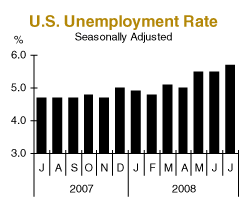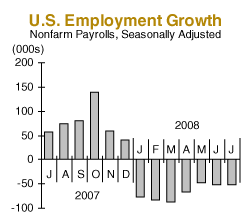|
August 6, 2008
The “R” Word
Written by Jeff Thredgold, CSP, President, Thredgold Economic Associates
…not recession…but revision
The U.S. Commerce Department’s latest revision to prior economic data now suggests (at least for the moment) that the U.S. economy has finally experienced a quarter of declining GDP. Gross Domestic Product (GDP) represents the economy’s estimated total output of goods and services.
|
As expected, the Federal Reserve left its key short-term interest rate unchanged at yesterday’s Federal Open Market Committee (FOMC) meeting. The Fed’s accompanying statement walked a fine line between concern about miniscule economic growth and higher inflation pressures.
The stock market liked the “fine line” approach as it suggested the Fed will likely remain on hold for some time to come. The Dow’s 331 point jump on August 5 was its best day since April 1.
|
|
The first official GDP estimate for 2008’s April-June quarter was a 1.9% real (after inflation) annual growth pace, below the consensus view of a 2.3% pace. However, the sharp downward revision to 2007’s final quarter was more newsworthy.
The Commerce Department now suggests the U.S. economy actually contracted at a 0.2% real annual rate during the October-December 2007 period, versus three prior estimates at or near a 0.6% growth pace…
…such a revision provides more substance for those suggesting a recession is currently underway.
The downward revision also now sees U.S. economic growth during 2007 at a 2.0% real rate, the weakest performance in five years. Note that additional revisions to quarterly data are at the whim of Commerce Department number crunchers…
…ahhhh, the life of an economist
The second quarter’s 1.9% real annual growth rate was positively impacted by $78 billion in tax rebates and rising U.S. exports to the world. Consumer spending rose at a 1.5% annual rate during the second quarter, outpacing the first quarter’s 0.9% rate.
While the economy has now strengthened during the past six months, such a pattern is not expected to continue. The economy is likely to slow during 2008’s second half, with a number of forecasters suggesting growth during either 2008’s final quarter or 2009’s first quarter, or both, could be negative.
The nation’s residential construction sector subtracted from overall economic growth for the 10th consecutive quarter, while exports added to growth totals for the eighth time in 10 quarters.
Continuing declines in oil prices would be a key positive for the economy in coming quarters. Conversely, a return to higher oil prices could sap what little energy the consumer has left at this point. Seven consecutive months of American job losses are not exactly a positive contributor to solid economic growth (see below)…
…stay tuned

Minor Seventh
The American economy recorded more of the same in July with the loss of another 51,000 jobs. The unemployment rate jumped to 5.7%.
 The loss of 51,000 net jobs during July was actually less painful than economists’ consensus forecast of a loss of 75,000 jobs. Moreover, job data of the two prior months was revised to show 26,000 fewer jobs lost than previously estimated… The loss of 51,000 net jobs during July was actually less painful than economists’ consensus forecast of a loss of 75,000 jobs. Moreover, job data of the two prior months was revised to show 26,000 fewer jobs lost than previously estimated…
…that’s where most of the good news stops
The nation’s jobless rate jumped to 5.7% in July, a four-year high, versus the 5.5% jobless rate of the two prior months. The jobless rate is now one full percent higher than a year ago.
Goods Production Pain
The manufacturing sector lost another 35,000 jobs in July, the 25th consecutive month of job losses, even as exports to the world remain strong. The construction sector also saw additional weakness, with a loss of 22,000 jobs, the 13th month in a row of decline. Natural resources & mining employment rose by 11,000 positions.
 Service sectors also struggled, with a net loss of 5,000 jobs. Education & health services continued to add jobs, with 39,000 net new positions. Government (mostly local) added 25,000 jobs, while professional & business services lost 24,000 jobs. Retail trade lost 17,000 positions. Service sectors also struggled, with a net loss of 5,000 jobs. Education & health services continued to add jobs, with 39,000 net new positions. Government (mostly local) added 25,000 jobs, while professional & business services lost 24,000 jobs. Retail trade lost 17,000 positions.
Teens
One of the toughest job markets on record for teenagers continued in July with the teen jobless rate moving to 20.3% from June’s 18.1% rate. Faulty seasonal adjustments may be part of the culprit here.
Year-to-date 2008 has seen a net decline of 463,000 jobs. An estimated 8.8 million people were considered unemployed in July, up from 7.1 million people a year ago.
Trailing Wages
The average hourly wage rose six cents (0.3%) to $18.06 hourly. Unfortunately, the 3.4% rise in the average hourly wage from 12 months ago trails the 5.0% rise in consumer inflation during the most recent 12-month period.
As is typically the case, those with higher levels of education were much more likely to be employed, while those with limited educational attainment suffered. Employees with less than a high school diploma recorded unemployment at 8.5%.
High school graduates with no college recorded a 5.2% jobless rate in July, while those with some college or an Associate’s degree had a 4.5% jobless rate. Those workers with a Bachelor’s degree and higher had a 2.4% jobless rate in July.
By Comparison
A U.S. economy likely in recession is still trimming jobs at a much less painful rate than during the recession of 2001. The loss of 463,000 jobs during 2008’s first seven months equates to an average of 66,000 monthly. Such a decline is much better than the average loss of 181,000 jobs monthly during the 2001 recession.
• Email this article to a friend
• Learn about econAmerica, Jeff’s latest book
|
|
Subscribe to the Tea Leaf
Like what you just read? Have Jeff Thredgold’s Tea Leaf emailed to you free each week. Subscribe today.
|
|
|

“Tea”ser
Duct tape is like the force. It has a light side, a dark side, and it holds the universe together.
• Send us a “Tea”ser

“Tea”stimonial
“Your talk at our Professional Day Convention in Greensboro, NC was exceptional. It is rare that we receive so many complimentary comments regarding one of our speakers.”
—James M. Morgan, III, CLU, ChFC, CFP, Chairman Professional Day Event, Society of Financial Service Professionals
• More testimonials
Invite Jeff Thredgold to speak at your next conference, meeting, or client function
If you like the Tea Leaf, you’ll love Jeff Thredgold’s live presentations. Jeff takes your audience on a timely, engaging, and entertaining tour of the U.S. economy and financial markets. Debunking some of today’s most common economic myths, he offers a clear picture of how the American economy is really performing and what that means for the future of your finances.
• Watch video clips of a Jeff Thredgold presentation.
• Download more information that you can e-mail to other decision makers.
• See Jeff Thredgold’s speaking calendar.
• Tell us about your event using our online form and we will contact you. Or, is there an individual in your organization you would like us to contact?
• Give us a call at 1-888-THREDGOLD (847-3346) to ask about Jeff’s availability and pricing for your event, or for any other information.
|
